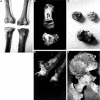Bone formers: osteophyte and enthesophyte formation are positively associated
- PMID: 9068279
- PMCID: PMC1752321
- DOI: 10.1136/ard.56.2.85
Bone formers: osteophyte and enthesophyte formation are positively associated
Abstract
Objective: To test the hypothesis that enthesophyte formation and osteophyte growth are positively associated and to look for associations between bone formation at different sites on the skeleton so that a simple measure of bone formation could be derived.
Methods: Visual examination of 337 adult skeletons. All common sites of either enthesophyte or osteophyte formation were inspected by a single observer who graded bone formation at these sites on a 0-3 scale. The total score for each feature was divided by the number of sites examined to derive an enthesophyte and an osteophyte score. Cronbach's alpha and principal components analysis were used to identify groupings.
Results: Enthesophyte formation was associated with gender (M > F) and age. There was a positive correlation between enthesophytes and osteophytes (r = 0.65, 95% confidence interval, 0.58 to 0.71) which remained after correction for age and gender. Principal components analysis indicated four different groupings of enthesophyte formation. By choosing one site from each group a simple index of total skeletal bone formation could be derived.
Conclusions: Osteophytes and enthesophytes are associated, such that a proportion of the population can be classified as "bone formers". Enthesophyte groupings provide some clues to aetiopathogenesis. Bone formation should be investigated as a possible determinant of the heterogeneity of outcome and of treatment responses in common musculoskeletal disorders.
Figures





References
MeSH terms
LinkOut - more resources
Full Text Sources

